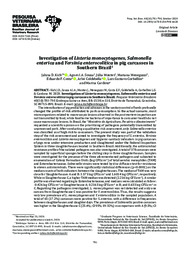Investigation of Listeria monocytogenes, Salmonella enterica and Yersinia enterocolitica in pig carcasses in southern Brazil.
Investigation of Listeria monocytogenes, Salmonella enterica and Yersinia enterocolitica in pig carcasses in southern Brazil.
Author(s): KICH, J. D.; SOUZA, A. I. A.; MONTES, J.; MENEGUZZI, M.; COSTA, E. de F.; COLDEBELLA, A.; CORBELLINI, L. G.; CARDOSO, M. R. de I.
Summary: Abstract: The intensification of pig production and advances in the sanitary control of herds profoundly changed the profile of risk attributed to pork consumption. In the actual scenario, most microorganisms related to macroscopic lesions observed in the post mortem inspection are not transmitted by food, while foodborne bacteria of importance to consumer health do not cause macroscopic lesions. In Brazil, the ?Ministério da Agricultura, Pecuária e Abastecimento? requested a scientific opinion on the prioritizing of pathogens potentially transmitted by unprocessed pork. After conducting a qualitative risk assessment, only Salmonella enterica was classified as of high risk to consumers. The present study was part of the validation step of the risk assessment and aimed to investigate the frequency of S. enterica, Yersinia enterocolitica and Listeria monocytogenes and hygienic-sanitary indicators in pig carcasses of pigs rose under intensive production and slaughtered under the Federal Inspection System in three slaughterhouses located in Southern Brazil. Additionally, the antimicrobial resistance profile of the isolated pathogens was also investigated. A total of 378 carcasses were sampled by superficial sponges before the chilling step in three slaughterhouses. Samples were investigated for the presence of the three aforementioned pathogens and subjected to enumeration of Colony Formation Units (log CFU.cm-1) of total aerobic mesophiles (TAM) and Enterobacteriaceae. Salmonella strains were tested by disc diffusion test for resistance to eleven antimicrobials. There were significantly statistical differences (p<0.0001) on the median counts of both indicators between the slaughterhouses. The median of TAM was very close for Slaughterhouses A and B: 1.573 log CFU.cm-1 and 1.6014 log CFU.cm-1, respectively. While in Slaughterhouse C, a higher TAM median was detected (2.216 log CFU.cm-1). A similar profile was observed regarding to Enterobacteriaceae, and medians were calculated as follow: -0.426 log CFU.cm-1 in Slaughterhouse A; 0.2163 log CFU.cm-1 in B; and 0.633 log CFU.cm-1 in C. Regarding the pathogens investigated, L. monocytogenes was not detected and only one carcass from Slaughterhouse C was positive for Y. enterocolitica. Thus, the results suggest a very low prevalence of L. monocytogenes and Y. enterocolitica in the sampled population. A total of 65 (17.2%) carcasses were positive for S. enterica, with a difference in frequencies between slaughterhouses and slaughter days. The prevalence of Salmonella positive carcasses was higher in the Slaughterhouse C (25.4%; CI 95% 19-32%) in comparison with A (9.5%; CI 95% 9-14%) and B (18.3%; CI 95% 12-24%). There was no significantly statistical association between Enterobacteriaceae counts and Salmonella isolation on carcass surface (p=0.69). The slaughtering day, nested within the slaughterhouse, explains 31.3% of Salmonella prevalence variability. S. Typhimurium (38.1%) was the most prevalent, followed by S. Infantis (30.1%). Among the 61 Salmonella strains tested for resistance to antimicrobials, 18 (31.6%) were full-susceptible. No strain displayed resistance to azithromycin, ceftazidime, cefotaxime and meropenem. The highest resistance frequency was displayed to tetracycline (54.1%), followed by ampicillin (50.82%), nalidixic acid (42.62%) and chloramphenicol (42.62). Multi-resistance was detected in 52.54% of the, strains. In conclusion, S. enterica is more prevalent in pre-chill pig carcasses than Y. enterocolitica and L. monocytogenes and thus should be prioritized in monitoring and control programs at slaughter. Salmonella serovars varied among slaughterhouses and present significant differences in their resistance to antimicrobials. Slaughterhouses that present higher medians of TAM or Enterobacteriaceae in a monitoring period may have higher S. enterica prevalences as well. However, there is a high variation of S. enterica prevalence among slaughter days, which cannot be always related to the hygienic indicators counts observed on a given day.
Publication year: 2020
Types of publication: Journal article
Unit: Embrapa Swine & Poultry
Keywords: Brasil, Carcaça, Salmonella Enteritides, Suíno
Observation
Some of Embrapa's publications are published as ePub files. To read them, use or download one of the following free software options to your computer or mobile device. Android: Google Play Books; IOS: iBooks; Windows and Linux: Calibre.
Access other publications
Access the Agricultural Research Database (BDPA) to consult Embrapa's full library collection and records.
Visit Embrapa Bookstore to purchase books and other publications sold by Embrapa.

